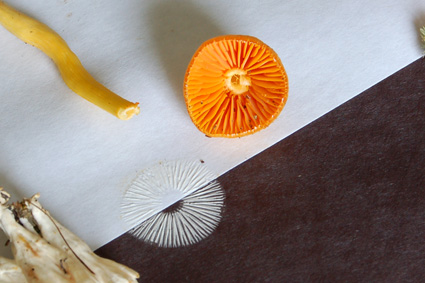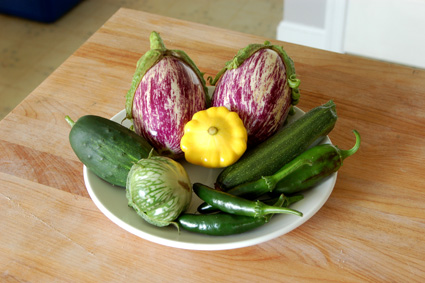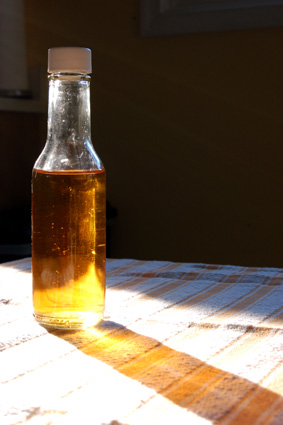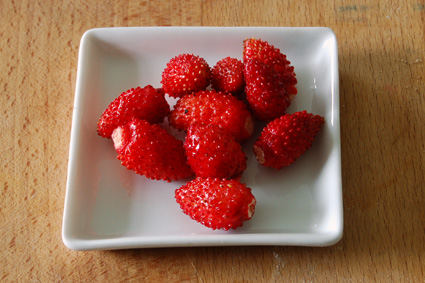Lewisburg.
I enjoy walking in the woods; it's generally relaxing, often great exercise, and increasing levels of engagement reward with more and more interesting things to see. There's just too much out there to take it all in.
Saturday, I went on a day hike with my dad and Ben, my sister's boyfriend, in the nearby State Forest lands. Ben hadn't really been on a hike since he was a kid, and my dad's been anxious to get out and get some exercise, though other obligations usually get in the way. So we picked a spot, parked the car, and just headed off. There was plenty to see, including vast fields of wild blueberries
1 ripening and ready for nibbling. Not much in the way of views, unfortunately, but I was busy staring at the ground for hours. This is, I discovered, a prime time for mushroom hunting.
Behold the haul:

I wasn't expecting to find much, but I did toss a few paper bags in my pack, just in case. Then, to my surprise, there was so much to find that I came home with my pack
2 completely full of mushrooms. Everything there on the table plus a monstrous bolete that ended up a bit too smashed for identification. With a cap about eight inches across and four inches high - plus stem - it was enormous. If I could have identified it, and it turned out to be edible, it would have been a meal for everyone.
Mushroom identification is, generally speaking, difficult. A few species are easy and straightforward; others are actually impossible. Of the thousands of different fungi growing in the central Pennsylvania woods, some sizable fraction is unidentifiable by anyone. Another chunk requires chemical tests and powerful microscopes to be certain. And often, even when you can figure out what it is - scientific name and all - there's no one who can say whether it's edible or not
3. That doesn't mean it isn't fun to try, though.
When I arrived home, I spread them all out on paper, both black and white, and did my best to keep the same types together. With some, I only had one or two of the fruiting bodies. Of one type, I had eight. And some had made the trip back in better shape than others.

There were, of course, numerous types of mushrooms that didn't make the trip home with me. One rather prevalent was the tough-to-miss fly mushroom,
Amanita muscaria. Orange and yellow, flecked with white, and alarmingly toxic. Even more alarming was what might have been
Amanita verna or one of its close relatives, which get charming common names like "Destroying Angel". Sure, I brought a few home that turned out to be inedible, and at least one that's definitely poisonous. Next time, I can skip over those.
The reason for the two papers is to get what's called a spore print. Leave the spore-producing surface - gills, pores, etc. - still for a while, and the spores will fall onto the paper. Some are light-colored; some are dark; it's rarely apparent what to expect. With both black and white, you can be sure to get a good reading.

With that information in hand, and a selection of reference guides, it's time to examine characteristics. I'm limited in that regard, since I can't pretend to afford a microscope that can distinguish between amyloid and non-amyloid spore shapes, and I don't keep potassium hydroxide and other handy mycological solutions around. Generally, if identification needs that sort of thing, I'm not going to try to eat it. Even with a number of positively identified mushrooms in my bag, I opted not to eat any. Though I might the next time out
4, since I know better what to look for.
I couldn't identify everything. In some cases, all I have is a possible genus. Sometimes not even that. There was only one that I knew for sure when I picked it up. For those who're curious, the mushrooms I found, more or less counterclockwise from upper left, are:
- Craterellus fallax, the black trumpet. The only mushrooms I knew without even pausing to think, I'd've eaten them if they weren't infected with a white mold. Even though they're just a bite.
- Possibly Lentaria byssiseda, but all I really know is that it's some sort of coral fungus. Most likely inedible.
- Another guess for Mycena strobilinoides, though the genus seems likely. Not the sort of thing I'd want to put in my mouth, but it was definitely an attention-grabber, and gave one of the best spore prints.
- Something in the Lactarius genus, so called because it exudes a milky fluid when cut. Some are edible; some aren't; this doesn't appear to be.
- I don't know. Crepidotus something, maybe, but even that's a shot in the dark. Not food.
- A small member of Boletellus, Boletus, or Chalciporus, I think, but nothing seemed to fit beyond that. Since it didn't give a good spore print, I can't be any more confident than that.
- No real idea. Possibly something in the Leccinum genus. Or not.
- Boletus affinis, which means it's actually edible. Not the most exciting mushroom around, from what the guides tell me, but it was exciting to get a positive identification for once.
- The Chanterelle Waxy Cap, Hygrophorus cantharellus, which I'd expected might be poisonous out in the woods. Bright reddish-orange doesn't always suggest safe to me, but apparently these are.
- Not sure again, though Cortinarius seems likely. Which means it's best left on the forest floor next time.
- The Jack O' Lantern mushroom, Omphalina olearius, I think, unless it's the other poisonous false chanterelle. If I'd had an inkling earlier, I could have peeked at it late last night. Like fireflies, these mushrooms produce luciferin and luciferase, which makes them glow pale green when it's pitch black.
- No clue. None whatsoever.
- Boletus affinis var. maculosus, which is almost the same as another one of the edibles I brought home. Aside from the yellow-brown spots on this one's cap, it's really the same mushroom; the nice part is that those spots make it easily identifiable.
- And last, the Bitter Bolete, Tylopilus felleus. Some folks mistake it for a tasty mushroom, and though it won't do you any harm, it's nasty bitter. Just a touch of the raw mushroom to the tongue leaves a taste that lingers, quite unpleasantly, for a minute or two. Though, should you be one of those rare people who lack the gene for sensing bitter flavors, it's apparently quite choice. Oddly enough.
* * * * *
1They were a great trail snack. Sweet, unmistakably blueberry, and in such near-endless quantities that you could reach down, without slowing your pace, and swipe a small handful to enjoy.
2Which is an entirely inappropriate way to carry a fungus harvest, but I needed my hands for rock scrambling, and I couldn't bring myself to leave it all there.
3In other words, it's not. Given that the world of mycotoxins is poorly understood, at best, and runs the likelihood of being the worst food poisoning you'll ever have.
4Some of mine weren't in prime shape when they got here, and the need to wait until a house full of company had left meant that a few picked up some mold growth. And some were in such small quantities that the half-forkful they'd have been after cooking wouldn't justify the cleanup.







